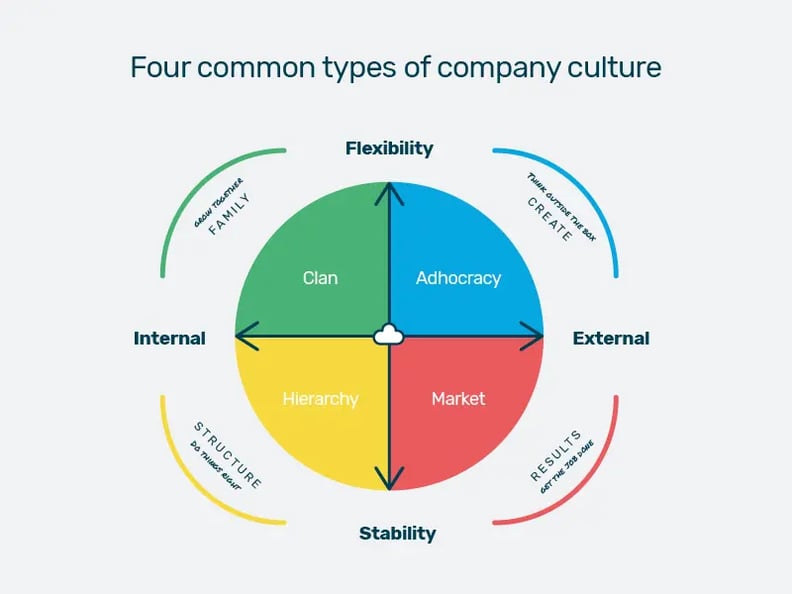If you’re wanting to drive your business forward, building a strong company culture is a necessity – and getting it wrong can be a very expensive mistake. And many businesses have come to realise this after being faced with serious issues with employee retention, productivity and engagement (to name a few).
So, focusing on your people might be a high priority on your list, but how can you even begin to think about developing your culture if you haven’t the faintest about where your business stands right now?
The Competing Values Framework, a cultural assessment tool coined in the 1980s established four types of company culture. In this blog post, we'll be exploring each of these and looking at key characteristics (along with the benefits and fallbacks that each of them carry).
Which one sounds most like your business?

Key takeaways:
- The Competing Values Framework identifies 4 culture types: Clan, Adhocracy, Market, and Hierarchy.
- Each culture has unique strengths and risks — from boosting innovation or collaboration to risking burnout or slow decision-making.
- Culture directly impacts retention, productivity, engagement, and business growth.
- In changing markets, cultural agility can help SMEs adapt and thrive.
- The first step is to assess your current culture so you can build on strengths and address gaps
What is company culture?
Company culture is how your business feels day to day. It’s the shared values, behaviours, and ways of working that shape how your team connects, collaborates, and makes decisions.
Think of it as your organisation’s personality. It’s not written in a policy – it’s felt in everyday moments. From how feedback is shared to how wins are celebrated (and mistakes handled), culture shows up in everything.
A healthy culture helps your business:
-
Attract and keep the right people – those who share your values.
-
Boost motivation and productivity – by building trust and clarity.
-
Strengthen your reputation – with customers, partners, and beyond.
On the flip side, a poor culture can damage morale, drive people away, and harm your brand.
That’s why culture isn’t just “nice to have.” It’s key to building a business where people thrive – and that starts with understanding what your culture is today, and where you want it to go.
What are 4 different types of company culture?
Clan culture
Otherwise known as "family culture’" a clan culture is friendly, upbeat and is made up of employees who have a lot in common with each other. The task of building and maintaining a strong company culture consistently stands as a top priority along with focusing on employee wellbeing.
Leaders of clan cultures are hugely respected and are often perceived as mentors or father figures. These leaders drive team building, employee involvement and empowerment. Business goals and company values are commonly shared by employees across the organisation, resulting in one streamlined universal vision and employees who are invested in the company’s mission.
By coming into a business that boldly demonstrates a clan culture, employees enjoy a harmonious and tranquil working environment and are given the trust and freedom they need to thrive in their roles. This type of culture is typically more common among start-ups as it helps to establish a collaborative culture where all ideas are welcome.
But, adopting a clan culture has its risks. By encouraging a social and fun environment, you’ll be running the risk of losing the work/fun balance and the office lacking authority. Additionally, you could be handing your staff an open opportunity to slack and become disengaged in their roles if you provide them with too much freedom. Monitoring is key in order to fully reap the benefits of a clan culture.
Adhocracy culture
Derived from the latin word ad hoc, meaning “for this”, adhocracy culture revolves around innovation, success and flexibility. This type of culture is often found within modern industries such as aerospace and technology. Businesses with adhocracy cultures are constantly thinking ahead and developing new products as they live by the assumption that all of their products only have a limited shelf-life.
The office environment is very creative, energetic and fast-paced. Leaders of an adhocracy culture are true entrepreneurs; they consistently encourage risks to be taken and push employees to experiment with new ideas. Adapting quickly to changing conditions is the norm in an innovative culture, so that the latest trends are reacted to and concentrated on.
But, working in an intense and fast-paced environment can take its toll. Employees may find the atmosphere in the office chaotic and disorganised and they may struggle to clearly understand their responsibilities. And, with innovation and risk-taking coming first, the health of the business can face a direct financial impact too if brave experimentations don’t quite go to plan.
For a good example of adhocracy culture in action, you only need to look as far as Facebook, where according to Mark Zuckerberg, you should “Move fast and break things”. He says that “unless you are breaking stuff, you are not moving fast enough”.
Market culture
And then there’s market culture. First becoming popular in the 1960s, market culture is ruthless, strongly results driven and performance orientated. Employees are encouraged to set difficult goals for themselves and work hard to achieve them and leaders are tough and demanding. Market share and profit at the forefront of the business focus at all times.
Adopting a market culture is rarely accidental, in fact it is something that is often deliberately integrated within the company in order to ensure that business objectives are a number one priority. It’s all about the company’s bottom line and financial growth with less of a focus on teamwork and community.
Whilst building a market culture most certainly brings benefits for business health, including optimised return rates, overtaking competitors and high employee motivation and engagement, it has its downfalls. And they can be pretty big. This can damage team relationships and weaken a customer-centric culture if not managed carefully.
With employees being pushed on a daily basis to maximise their performance and hit difficult targets, the competitiveness can often be taken too far and lead to dishonesty and conflict in the office, which you as an employer will need to step in and deal with. This friction may even result in team members who are disconnected from their work, a slump in productivity levels, and in serious cases a financial hit to the business.
Hierarchy culture
The most traditional type of culture, hierarchy culture revolves around structure, control and “doing things right”. The working environment will be extremely organised with well-polished policies and procedures. Keeping the business running smoothly is key.
Unlike in a clan culture, there are strict rules, and leaders are likely to be keeping a close eye on what employees are doing. There are several layers of management between leadership and employees, many more than that in other cultures, and leaders are highly respected by their teams.
This type of culture is the most historical and goes back as far as the mid 1900s. Imagine your typical large bureaucratic company, such as McDonalds – they're more than likely to be accurately demonstrating a hierarchy culture.
The benefits speak for themselves with hierarchy culture; there are little or no issues with authority and boundaries are clear. Responsibilities are allocated by job level and lines of communication are seamless.
However, with a strict, “by the book” culture comes its drawbacks. With power sitting at the top level of the business, a business leader may find that they are too absorbed in everyday decision-making to invest any time in their people. When sole decision-makers further up the ladder, communications can become slow, which may stifle an inclusive culture and hinder fast adaptation in dynamic industries.
Employee one-to-ones may not happen as frequently (or at all) and appraisals are dropped down on the priority scale.
The structure of a hierarchy in itself can cause issues, too. With the sole decision-makers further up the business ladder, communications become slow and time-consuming, which can prove problematic in fast-moving, dynamic working environments.
Examples of companies with strong organisational culture
To see the Competing Values Framework in action, let’s look at five well-known businesses that have built standout cultures, each reflecting different priorities, strengths, and lessons.
Netflix – Adhocracy Culture with high autonomy
Netflix’s culture is built on freedom and responsibility. Their famous Culture Deck outlines principles such as avoiding rules, hiring “fully formed adults,” and valuing innovation over process. Leaders encourage calculated risk-taking and give employees significant autonomy to make decisions - keeping the business agile in a fast-changing entertainment industry.
Read more on Netflix’s culture
Lesson SMEs can copy: Trust your people to make smart choices without micromanaging. Set clear goals, then give teams the freedom to figure out the best path to achieve them.
Patagonia – Clan Culture rooted in purpose
Patagonia blends a close-knit community with a shared mission to protect the environment. Employees are encouraged to take time for outdoor activities, activism, and volunteering, which strengthens both wellbeing and purpose. Transparency and ethical leadership attract those who share Patagonia’s values, resulting in high retention and deep loyalty.
Lesson SMEs can copy: Embed your mission into everyday work. Even small gestures - like aligning perks, CSR activities, or events with your values - can make your culture more meaningful.
Google – Adhocracy Culture driving innovation
Google fosters creativity and experimentation through initiatives that lets employees dedicate part of their week to passion projects. Collaboration across teams is actively encouraged, and leadership supports a “fail fast” mindset to quickly learn from experiments.
Learn more about Google’s culture
Lesson SMEs can copy: Create space for innovation. This could be regular brainstorming sessions, “hack days,” or simply encouraging employees to pitch and test new ideas.
Zappos – Clan Culture with a customer-first mindset
Zappos is famous for making company culture a priority, so much so that they’ll offer new hires a cash bonus to quit if the fit isn’t right. Their culture promotes fun, individuality, and going above and beyond for customers, which fosters loyalty both inside and outside the company.
Lesson SMEs can copy: Prioritise cultural fit in hiring, and encourage employees to bring their authentic selves to work - because happy teams deliver better service.
HubSpot – Clan Culture focused on HEART values
HubSpot’s values - Humble, Empathetic, Adaptable, Remarkable, Transparent - shape everything from leadership style to customer service. They emphasise flexibility, trust, and empowerment, and their “no-door” policy ensures leadership remains approachable and open.
Lesson SMEs can copy: Define your values clearly, live them consistently, and use them to guide hiring, performance reviews, and decision-making.
These examples show there’s no single “perfect” culture - but there is a right culture for your business. The key is making it intentional, consistent, and lived daily.
How can you improve your company culture?
Improving your company culture doesn’t happen overnight - but small, intentional changes can create a big impact over time. If you’ve identified your culture type and seen how other organisations make theirs work, the next step is action.
Here’s how you can start improving your company culture today:
1. Clarify your vision, mission, and values
Your people need to understand where the business is headed and what it stands for. Make your values visible in daily operations, not just in policy documents - refer to them in decision-making, performance reviews, and hiring.
2. Strengthen leadership and communication
Leaders set the tone. Encourage open, honest communication and model the behaviours you want to see. Regularly check in with teams, share updates transparently, and actively listen to feedback.
3. Foster trust and psychological safety
Create an environment where employees feel safe to share ideas, raise concerns, and admit mistakes without fear of blame. This encourages innovation, problem-solving, and stronger team relationships - key qualities for both a collaborative culture and an inclusive culture.
4. Recognise and celebrate achievements
Acknowledge both big wins and everyday contributions. Public praise, personal thank-yous, and meaningful rewards show employees their efforts are valued.
5. Encourage collaboration and inclusivity
Break down silos by creating opportunities for cross-team projects and social interaction. Commit to diversity and inclusion initiatives that make everyone feel they belong.
6. Invest in employee growth and wellbeing
Support development through training, mentorship, and clear career pathways. Pair this with wellbeing initiatives - flexible working, mental health support, or wellness programmes - to keep your team healthy and engaged in an innovative culture.
7. Gather feedback and adapt
Culture isn’t static. Use surveys, one-to-ones, and informal conversations to understand employee sentiment, then act on what you learn. Adjust initiatives based on what’s working (and what’s not) to keep your business truly customer-centric.
Your company culture matters
Whichever type of culture your small business falls under, it’s important you get it right. And, because every culture works differently, assessing and identifying your business' culture is a great place to start.
Whether you’re aiming for a more collaborative culture or want to nurture an innovative culture, intentional action is key.
Our People First Culture Series edition 4 offers actionable tips on culture agility, collaboration and psychological safety.
FAQs
Q: What are the main types of company culture?
A: The Competing Values Framework identifies four culture types: Clan, Adhocracy, Market, and Hierarchy. Each has unique strengths and challenges, from the trust and connection of a collaborative culture to the agility of an innovative culture.
Q: How does culture impact business performance?
A: Culture shapes employee engagement, retention, and productivity. A strong culture boosts morale, attracts the right talent, and improves decision-making. For example, a customer-centric culture can enhance service quality and customer loyalty.
Q: Can small businesses change their company culture?
A: Yes, small businesses can adapt their culture through intentional leadership, clear values, and consistent practices. This may involve fostering an inclusive culture where all employees feel valued and able to contribute.
Q: What are quick ways to improve company culture?
A: Some quick wins include recognising employee achievements, encouraging cross-team collaboration, gathering feedback regularly, and aligning perks with your mission. These steps can strengthen engagement and create a customer-centric culture.
Q: How do you know if your culture is inclusive?
A: An inclusive culture is one where diverse voices are heard, policies promote fairness, and all employees feel respected. Regularly seek feedback, review hiring practices, and ensure everyone has equal access to opportunities.
.webp)
Author: Sarah Benstead
Sarah is a Product Marketing Specialist here at Breathe. Always innovating, she loves writing about product releases in an engaging & informative way. When she's not coming up with new ideas, she enjoys long walks with her dog, Clifford.






